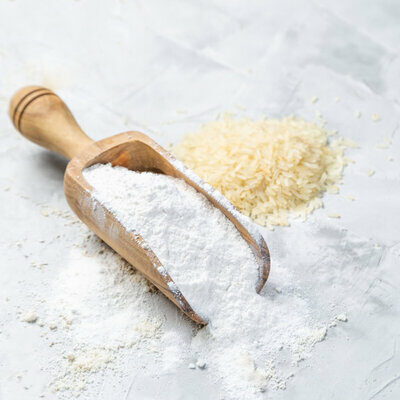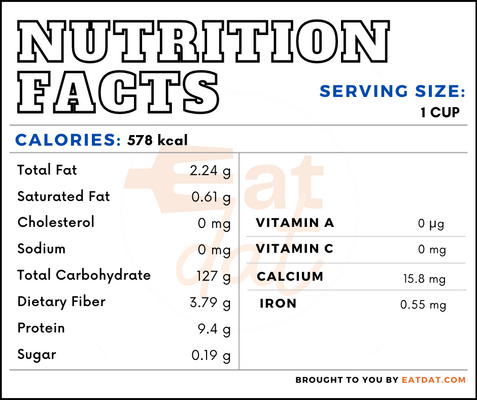
Rice Flour
What is Rice Flour?
Rice flour is a type of flour made from finely milled rice. Any type of rice may be used to prepare this flour. It is considered to be a common gluten-free alternative to wheat flour. Also, it may be used as batter for fried dishes and as a thickening agent for stews, soups, and gravies.
- It is used to prepare flatbreads and is also sometimes used in preparing sweets.
- This flour has a neutral taste and is a significant part of the cuisine in certain parts of Asia including Southeast Asia, India, Nepal, Bangladesh, Sri Lanka, Korea, and Japan.
Some of the most popular rice flour brands include:
- Anthony’s
- Arrowhead Mills
- Bob’s Red Mill
- PuroRaw
- Erawan
- Naturtonix
- Naturevibe Botanicals
Origin of rice flour
Rice has been domestically grown since at least 9,400 years. Archaeological evidence shows that rice was first domesticated in China near the Yangtze River. Gradually, the cultivation spread throughout East and Southeast Asia. This was the japonica variety of rice, which then split into another major variety around 3,900 years ago to create the Oryza sativa variety. Rice is a staple food for more than 50 percent of the world’s population. While the exact date people began milling rice into flour is not known, this ingredient remains important in cuisines around the world.
Nutrition
Nutritional profile for rice flour (1 cup):

Rice flour is a good source of carbohydrates and is also high in phosphorus and potassium. Also, it contains calcium, magnesium, selenium, folate, and choline. Regular consumption of rice may aid sleep and improve brain health.
Brown rice is rich in phytochemicals, phytic acid, antioxidants, and B-vitamins. Most of the nutrients are contained in the bran and germ layers. It may help to reduce the risk of diabetes, atherosclerosis, cardiovascular diseases, pancreatitis, and certain types of cancers. Also, it helps in lowering cholesterol and blood pressure. In addition, glutinous rice provided several benefits. However, white rice may lead to an array of health problems including increased risk of diabetes.
Commercial production
The main types of rice flour include white, brown, and glutinous rice flour. Rice flour is prepared by roasting the rice and then milling it. For polished rice flour, it is first polished by applying to a polisher for shaving bran. Then, the rice is soaked in water and dried before being milled.
The three main methods of grinding rice flour are wet grinding, dry grinding, and semi-dry grinding. In wet grinding, the rice is first soaked in water and then ground into a paste. Then, this is filtered and dried to obtain its powder form. For dry grinding, rice is broken and then ground into a flour by using machinery. For the semi-dry method, rice is first soaked in water and then dried to remove the excess water. Finally, it is ground into a flour by using machinery.
Rice flour recipes
This flour can be used in a variety of recipes, from fried foods like Lumpiang Shanghai to baked goods to soups and flatbreads to sweets. Here are a few recipes to try:
- Akki Roti
- Thattai
- Phirni
- Neer Dosa
- Appam
- Mani Pittu
- Handesh
- Patishapta Pitha
- Hanami Dango
- Daifuku Mochi
- Mochi Ice Cream
- Garatteok
- Tteokbokki
- Kanom Krok
- Puto
- Num Kom
- Kuih Seri Muka
- Kuey Teow
- Madeira Cake
- Bibingka
FDA regulations
There is no specific standard of identity for rice flour. However, the Food & Drug Administration categorizes rice as a raw agricultural commodity and regulates its growing, harvesting, and packaging. The FDA also offers a reference amount consumed per eating occasion for this grain.
References
Sarah Zhang, Rice Was First Grown At Least 9,400 Years Ago, The Atlantic, https://www.theatlantic.com/science/archive/2017/05/rice-domestication/528288/
Gaesser, Glenn A. “Perspective: Refined Grains and Health: Genuine Risk, or Guilt by Association?.” Advances in nutrition (Bethesda, Md.) vol. 10,3 (2019): 361-371. doi:10.1093/advances/nmy104, https://www.ncbi.nlm.nih.gov/pmc/articles/PMC6520038/
Yeh, An-I. (2004). Chapter 17: Preparation and Applications of Rice Flour. 10.1094/1891127349.017., https://www.researchgate.net/publication/286431447_CHAPTER_17_PREPARATION_AND_APPLICATIONS_OF_RICE_FLOUR
Koga, Minori et al. “PT739. Rice is nice: benefits of rice consumption for brain health.” International Journal of Neuropsychopharmacology vol. 19,Suppl 1 69. 27 May. 2016, doi:10.1093/ijnp/pyw044.739, https://www.ncbi.nlm.nih.gov/pmc/articles/PMC5617070/
Ravichanthiran, Keneswary et al. “Phytochemical Profile of Brown Rice and Its Nutrigenomic Implications.” Antioxidants (Basel, Switzerland) vol. 7,6 71. 23 May. 2018, doi:10.3390/antiox7060071, https://www.ncbi.nlm.nih.gov/pmc/articles/PMC6025443/
